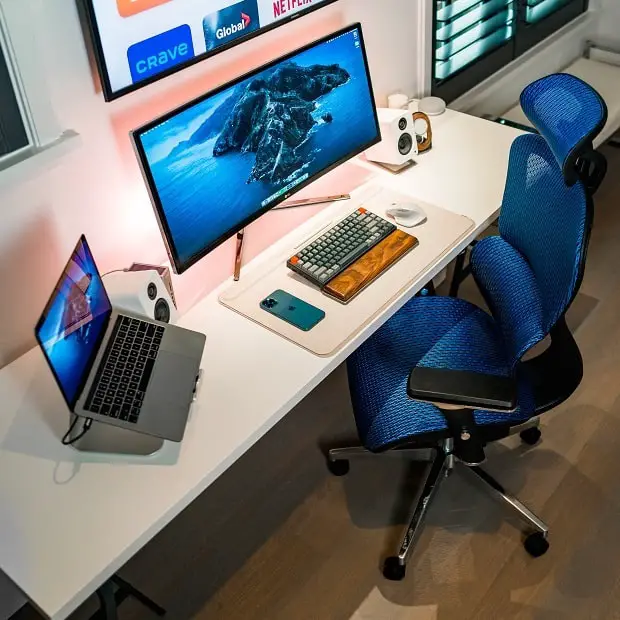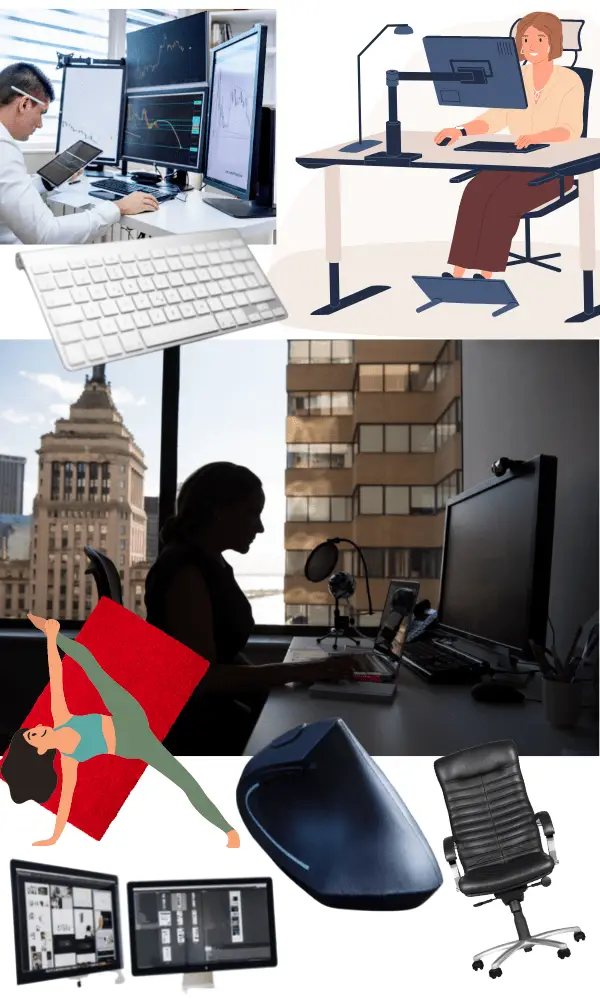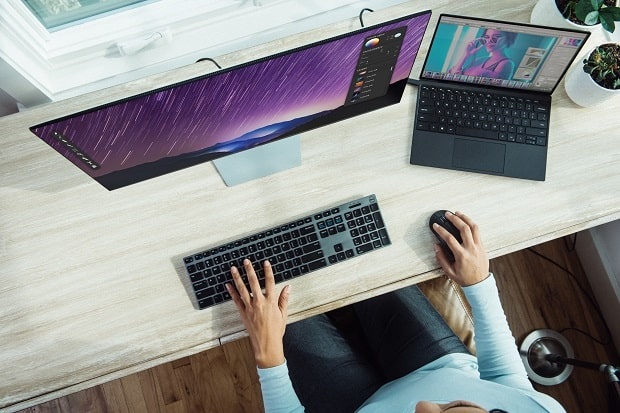
In the remote work age, an ergonomic home office setup is a must.
Spending eight hours a day typing, slouching, or craning can take a toll on your body. You get muscle aches, your eyes get tired, dry, or itchy, and then there’s the constant neck and back pain. In short, poor ergonomics can make or break your work-from-home experience. It’s high time to equip yourself with ergonomic furniture and a few gadgets to create a comfortable and productive workspace. Here’s how to set up an ergonomic workspace in your future apartment like the one in the forte of Rochester Rochester MN which fits and supports you best.

How to Create an Ergonomic Setup for Home Office:
1. Get a comfortable chair that supports your spine well
In today’s work-from-home setting, ergonomic office chairs are very important, as they help reduce shoulder, back, and neck strain. Even though they cost more than a standard office chair, they are a wise investment. Simply because they not only conform to your spinal curves but also promote good posture and increase overall work satisfaction. Before buying one, make sure you sit on it to check whether the width and depth of the chair are right for you. A good chair doesn’t have to be expensive. I bought mine for around $160, and it even has a pull-out leg rest, which makes a huge difference when you want to chill for a while. Make sure you can tilt the backrest easily and experiment with different settings. The worst thing you can do is stay in the same position for too long.

Working for hours at your desk will be more comfortable if you have an ergonomic office chair that supports your back well.
2. Adjust your ergonomic chair properly
Simply buying an ergonomic office chair is not enough. It must be set up correctly to get the most out of it. The first thing to look at is your chair’s height about your desk. Adjust the height of the chair so that your feet rest firmly on the ground and your thighs are parallel to the floor. When you adjust the height, make sure your elbows are bent to 90 degrees. Other components, such as the headrest, armrests, lumbar pillow, and footrest (if there are any) must be adjusted too to provide maximum comfort. Licensed occupational therapists highly recommend the proper adjustment of your office chair setting. It helps prevent or minimize fatigue, tension headaches, back pain, and other discomforts associated with working on a computer for long hours.
3. Adjust your lower back positioning
Once you’ve got your chair set properly, it’s time to think about the backrest. The backrest of the chair can be raised or lowered according to your preference or requirements. The most pronounced part of the chairs should align with the small of your back. You can also alter the back angle to conform to the work position you are most comfortable with. Remember, your lower back positioning is equally important to help ensure you maintain good posture.
4. Set your desk at the proper height
The next thing you want to look at is where your monitor should be. When creating an ergonomic setup for a home office, your computer laptop, or monitor, should be at the right height and viewing angle. A height-adjustable workstation can help you position your monitor at the most comfortable height. You don’t want it to be too low or too high. If you do not have an adjustable workstation, you can use a kickstand to raise the desk to your desired height.

It is wise to invest in a height-adjustable desk because it gives you the flexibility to shift from a sitting to a standing work position and vice versa.
5. Position your monitor to make it ergonomically correct
Ideally, the monitor is close enough, about an arm’s length, so can read without having to strain your eyes or bend forward to adjust your posture. Make sure the monitor is not too close or too far away and you’re still able to maintain your elbows bend at 90 degrees, as well as your hip and knees. You can raise the monitor to the top of the screen levels with your eyes. If your monitor is not adjustable, you can use reams of paper to raise it.
6. Mind your mouse and keyboard
Bad posture and wrong positioning of the keyboard and mouse are typically associated with upper limb disorders and shoulder aches. So, have your keyboard and mouse positioned in front of you. Remember, where your hands end up is exactly where your keyboard should be. The mouse and keyboard should be on the same surface and within easy reach. Another great tip is to learn to use keyboard shortcuts to avoid extended use of the mouse.

Getting an ergonomically designed mouse and keyboard can help reduce hand and wrist strain.
7. Use an ergonomic keyboard and mouse
If possible, go for an ergonomic keyboard and mouse combo that is designed with a human-centric approach. Ergonomic keyboards are specifically designed to provide more space for your wrist and forearm to increase comfort and reduce muscle strain. An ergonomic keyboard and mouse help prevent stress on your tendons because your hands and arms rest in a natural position. It also reduces the risk of developing carpal tunnel syndrome. Many companies pay for ergonomic setups for home offices for employees who need them.
8. Position your phone correctly
If your job requires talking on the phone while typing or writing, make sure you don’t put the phone in your writing hand because it creates a pinch in your neck and causes discomfort. So, it’s recommended to put the phone on your non-writing side, so you don’t have to cradle it on your shoulder. If you’re on the phone for most of your working hours, you might use a headset so that your hands are free to write anything or to type on the computer.
9. Install better lighting in your home office
The one thing many people overlook in their home office setups is proper lighting. When talking about creating a comfortable workspace at home, efficient lighting is an essential component for a more productive workspace. If you have adequate lighting in your seated setup, it enhances your focus and helps you concentrate while working. Proper illumination without glare or shadows can reduce eye fatigue and headaches. It also increases your visibility in moving around objects in your workspace. Insufficient lighting makes your space feel cramped.

While natural lighting is still the best, having a ceiling or desk lamp with an energy-efficient LED bulb can make your workspace more conducive for you to be more productive.
10. Practice movement while working from home
The next and most important thing you need to focus on while working from home is movement. Make sure you get up, stretch, and move about every hour to stay active. You can practice some basic exercises while sitting on your chair to keep yourself from going idle. It’s probably not much, but it is better than sitting and typing for hours without even moving an inch. Keep your exercise equipment nearby so you can pick up some healthy routine when taking a break. And do not hesitate to take breaks.
Final Thoughts
You must get off your chair every hour. Get up and pace the floor, get something to eat or drink, pet your dog, or water your plants, just do something. If you feel any discomfort in your current setup, try to experiment with it. Adjust your chair’s configuration, raise, or lower your monitor, or practice shifting from a sitting to a standing work position from time to time. Double-check your adjustments and assess if you feel comfortable after an hour or two. If not, continue experimenting with the setup until you get a blissful feeling in your remote workspace.
Hey there, welcome to my blog! I'm a full-time entrepreneur building two companies, a digital marketer, and a content creator with 10+ years of experience. I started RafalReyzer.com to provide you with great tools and strategies you can use to become a proficient digital marketer and achieve freedom through online creativity. My site is a one-stop shop for digital marketers, and content enthusiasts who want to be independent, earn more money, and create beautiful things. Explore my journey here, and don't forget to get in touch if you need help with digital marketing.

